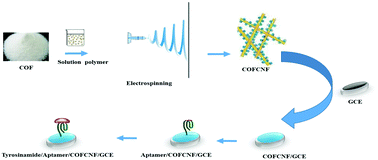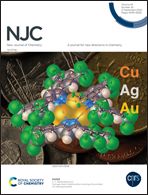Facile synthesis of a covalent organic framework (COF) based on the reaction of melamine and trimesic acid incorporated electrospun nanofiber and its application as an electrochemical tyrosinamide aptasensor
Abstract
In this research, for the first time, a high-performance electrochemical aptasensor assay based on electrospun covalent organic framework (COF) nitrogen-doped carbon nanofiber (COFCNF) was designed and dedicated to tyrosinamide sensing. The COF is prepared via a condensation reaction between trimesic acid and melamine. The COFCNF has been used to modify the electrode surface in an electrochemical sensor based on the aptamer because the COFCNF increases electrochemical activity. The as-prepared nanofibers were characterized by Brunauer Emmett Teller analysis, Field emission scanning electron microscopy, Fourier transform infrared spectroscopy, and X-ray diffraction. Electrochemical impedance spectroscopy and cyclic voltammetry were used for the fabrication and assessment of the proposed aptasensor in Fe(CN)64−/3− as a redox probe. The proposed aptasensor for tyrosinamide has a detection limit of 0.53 pM and linearity from 0.0016 to 0.08 nM and 0.08–9 nM.



 Please wait while we load your content...
Please wait while we load your content...